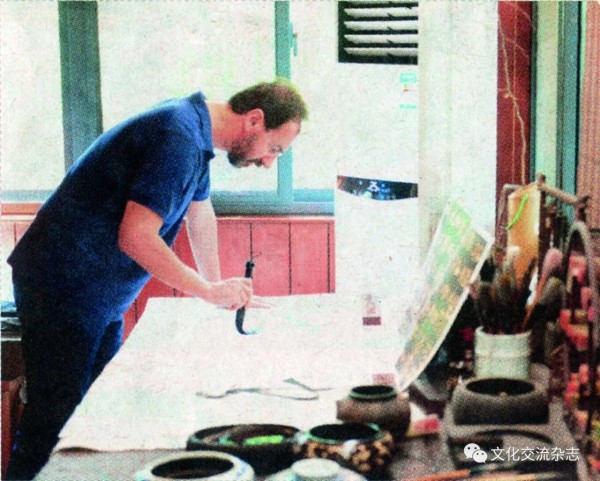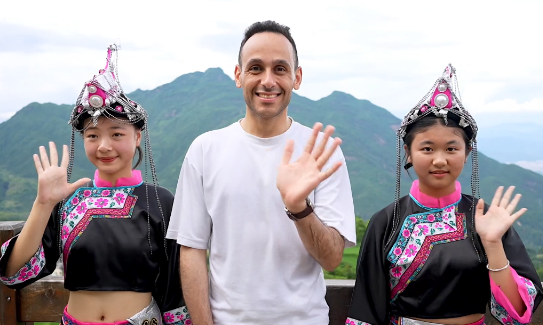Chinese Calligraphy as I See It

Pietro De Laurentis [Photo/WeChat account: culturedialogue]
I first visited China in 1998. Since then I have visited the oriental country numerous times. Of the cities in China, I love Beijing and Shanghai for various reasons and I love Tianjin, Xi'an and Luoyang for their rich historical heritage and cultural wealth. Hangzhou is unique, however, because it gave me enlightenment on Chinese calligraphy.
In the spring of 2019, I visited Shaoxing and attended a ceremony in honor of Wang Xizhi (303-361), a great Chinese master of calligraphy, whom I referred to as China's Da Vinci when I explained the purpose of my visit to my mother. "His amazing calligraphy demands the attention of the world. I will submit my research result and engage in exchanges with international colleagues," I explained.
International and Chinese scholars attended the event. I was engaged as a specialist at a research center there. At the end of 2019 I gave a lecture at Shaoxing Municipal Library. Many people there were curious about my research, mainly because they knew there were few westerners specialized in Chinese calligraphy. After the public lecture in Shaoxing, Sichuan People's Press engaged me to write a book about Wang Xizhi's calligraphy. The book is scheduled to be published in 2020.
When I began studying Chinese calligraphy in Hangzhou in 2000, I had the slightest idea that I was to write books in Italian, English and Chinese about Chinese poetry and calligraphy. The first calligraphy course I took at China Academy of Art in Hangzhou lasted from 2000 to 2001. The second calligraphy course I took at Zhejiang University in Hangzhou lasted from 2004 to 2005. My understanding of China and calligraphy took shape during these two special courses.
I took interest in Chinese calligraphy in 1999 in an Italian university. I had a Chinese calligraphy teacher named Wang Chengxiong, a native of Shanghai. I have been practicing Chinese calligraphy under Wang’s guidance since then. I met Wang and we became friends pretty fast. With him as my teacher I made fast progress in writing Chinese. I had a few Chinese friends who also hailed from Shanghai. When I chatted with them about my intention to study calligraphy in China, they unanimously suggested Hangzhou: Hangzhou is a city of calligraphy and the city hosts China Academy of Art. I knew clearly that I needed to be in an authentic atmosphere to experience Chinese calligraphy.
So I came to Hangzhou in 2000. As an international student of China Academy of Art, I lived in a special dorm near the campus. Back then, Hangzhou was relatively underdeveloped. I bought a bicycle and pedaled around randomly in my spare time. Whenever I started a bike adventure, I picked a road arbitrarily. As I pedaled along, I enjoyed going wherever distractions and attractions led me. I never followed the same road back. I just moved ahead. I felt safe in China and even if I got lost, I could easily find a taxi to get back to the dorm.
The course at the academy was a primary one. What I learned there was the essentials of how to use a brush pen to write. However, this course did not give me enough to write a dissertation on the sources of Chinese calligraphy. I had applied for a Chinese scholarship for writing the dissertation to be submitted and then defended toward the end of 2002 in Italy. I was interested in academic study of Chinese calligraphy, but the course I took at the academy was in another direction.
After I became a doctoral candidate toward the end of 2003, I immediately made up my mind to take a course in Hangzhou, for I really wanted to know everything about Chinese calligraphy. I needed to take a close look at the calligraphy literature in early history of China. Such a study was not likely in Italy. And unlike some sinologists who studied Chinese calligraphy, I wanted to be an excellent calligrapher. Writing like a qualified calligrapher would help a great deal for a profound academic study of calligraphy. Only in China can an international student become a really good calligrapher. I still think so today.
Interestingly enough, it was during my second study in Hangzhou that I dismissed the previous doctoral dissertation and decided to focus on Treatise on Calligraphy by Sun Guoting (646-691), a Chinese calligrapher of the early Tang Dynasty. The work was the first important theoretical work on Chinese calligraphy, and has remained important ever since, though only part of it survived. I happened to see a copy of the treatise in a display gallery by a bus stop in Hangzhou in the early 2001 when I was taking my first course in calligraphy at China Academy of Art. I was profoundly impressed by the grandeur and elegance of the long scroll replica which is 9.06 meters long.
The second course I took was a graduate course at Zhejiang University. I studied under the guidance of Professor Chen Zhenlian, a prominent calligrapher. It was at Zhejiang University that I got really immersed in academic studies. I learned to view academic issues from historical and cultural perspectives. I made rapid progress largely because of the rich resources available at the university and because I got useful help and feedback from classmates in the same course. Among them was Yao Yuliang, now a professor of Guangzhou Academy of Fine Arts. Yao and other friends directed me to take a closer look at the nuances of calligraphy, which I wouldn’t have noticed if they hadn’t guided or demonstrated to me. As I planned to write a treatise for the graduate course, I spent more than a year writing a treatise titled the Style of Treatise on Calligraphy in Chinese. In the spring of 2005, Professor Chen examined my treatise and praised me in front of all my classmates. He said the treatise was good enough for publishing with some minor amendments. I was very happy. This treatise later became the core of my doctoral dissertation. After the doctoral dissertation, I wrote a book which was centered on the graduate treatise.
I did not finish my graduate course at Zhejiang University. After weighing pros and cons of several options, I decided to give up the graduate course and go back to Italy to finish my doctoral study. As a sinologist in the west, I need to abide by an international academic perspective before I can conduct a dialogue with other sinologists. I finished my doctoral dissertation and attained a PhD degree. Now I teach at University of Naples "L'Orientale". I have kept constant contact with Chinese colleagues and friends.
Since then I have visited Hangzhou many times for taking part in academic programs and meeting friends.
In 2018, I wrote a dozen articles about my 20-year experiences in China. They were published in Calligraphy, a professional monthly founded in 1977 and based in Shanghai.
From 2007 to the second half of 2019, I held public lectures at universities and libraries across China. The interaction between the public and me at these lectures was pleasurable and eye-opening. I cherish such an experience because I think the positive response of the public means that calligraphy is more than an academic subject studied only at higher education institutions and that it is a cultural experience the public appreciate and enjoy.
-
Foreign teacher, Hangzhou students capture picturesque countryside
August 9, 2023
-
Hangzhou Asian Games launch 50-day-to-go campaign
August 4, 2023
-
Hangzhou achieves 6.9% GDP growth in H1 2023
July 27, 2023



